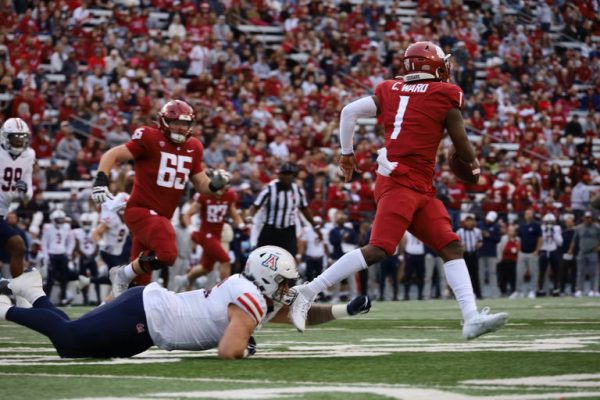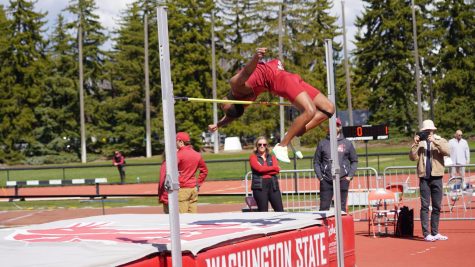Perseverance drives track and field athletes
March 20, 2017
A trio of WSU track and field athletes made victory at last weekend’s USC Trojan Invite.
Senior CJ Allen opened his outdoor season with a win in the 400-meter hurdles in a time of 50.43 seconds. Allen, a 2016 second-team All-American, finished with less than three-tenths off his lifetime-best mark of 50.16.
In the field, redshirt junior Cole Smith won the men’s javelin with a five-foot personal record throw of 216 feet 7 inches, while freshman Atina Kamasi took first place in the women’s javelin with a heave of 155-6, good enough for 10th-best in WSU’s all-time records, in her first collegiate outdoor meet.
This past weekend’s performance inspired me to share a little about my own knowledge of track and field as a high school competitor.
Millions of high school athletes sign up for track and field with the turn of winter into spring each calendar year, yet the NCAA estimates just 5.3 percent of those athletes have the chance to compete at the collegiate level. Furthermore, only 1.9 percent of male athletes and 2.3 percent of female athletes are presented with the opportunity to compete at the division one level.
To compete at a high level in any sport is a daily challenge. Any athlete can attest that the constant tests of endurance, strength and will extend beyond just professional and collegiate athletics.
With that said, track and field often garners a different reputation from other sports. Runners, jumpers and throwers are thought of as natural athletes, as though there is a magical ability bestowed upon the 5.3 percent fortunate enough to receive consideration to continue competing after high school. It’s like somehow, something is out there that makes them ‘just that good.’
What aren’t surprising, however, are the similarities between track and field and most other sports in terms of what it takes to improve.
Improvements in track rarely come in bunches. I ran track in high school and my personal best in sprinting events jumped just one second between my freshman and senior seasons. By no means was I the fastest sprinter on the team or the furthest jumper, but I became quite familiar with the idea of small improvements in my quest to become a better athlete.
Regular weight workouts, hours on the track and countless run-throughs on the long jump runway all manifested as a few more inches on a jump or a tenth of a second subtracted from my 100-meter personal record.
Improvements in track and field coming in small samples, particularly for sprinters, means that being an exceptionally strong athlete requires a different mentality than that of other sports.
I personally struggled with this, but was lucky enough to be on a high school team that sent multiple athletes to division one programs.
At Issaquah High School, I competed alongside WSU sophomore decathlete Ray Littles, sophomore sprinter Jake Nuenhuis and freshman distance runner Kennan Schrag.
Obviously, each of these three WSU athletes excelled at different events, but they shared similar instances and displays of persistence.
Some got injured and most had a rough meet every once in a while, but none of that mattered when the workouts started or a meet commenced. The most successful athletes I saw on that team, those called the ‘naturals,’ put forth a full effort in every workout.
Competing in collegiate track and field takes a special kind of athlete. The long waiting time for improvement and fatiguing nature of the sport’s events can mentally feel like slamming your head into a wall repeatedly.
Athletes like Allen, Smith and Kamasi are the select few; the 5.3 percent of high school track and field athletes that made it through all the waiting and all the ‘just so close’ moments and kept going.
High-level track athletes all seem to have one thing in common: they have the drive to keep going. They push through the longest workouts, kick a little bit more than the person running next to them at the end of a race and often collapse to their knees at the finish line.
Track and field is one of the most mentally grueling sports on the planet. What separates the top 5.3 percent from the rest is not natural talent, but the mentality of constantly pushing and improving.
Ask any of the three WSU athletes who won their events last weekend. Those marks were not solely earned based off a good winter training circuit or solid indoor season. Allen, Smith and Kasami out-dueled their competitors with a mentality that began its development the first time they each took up their respective event.
















